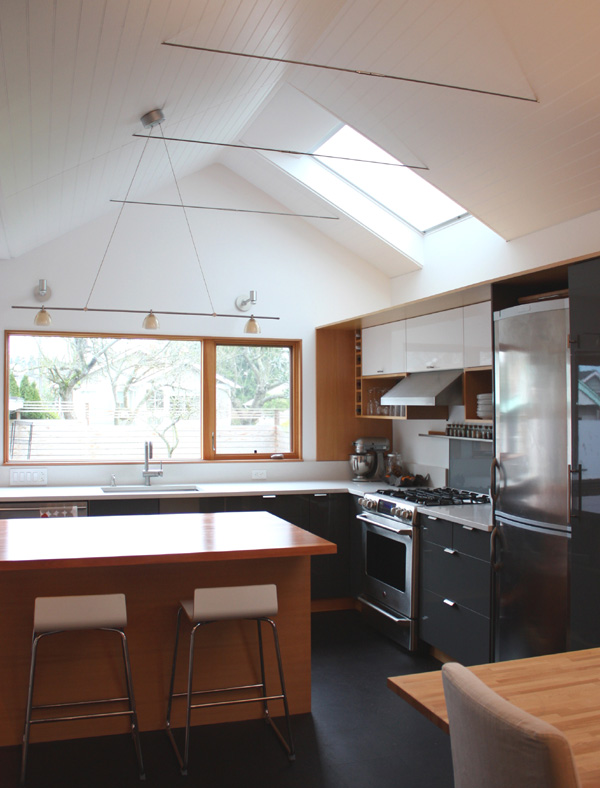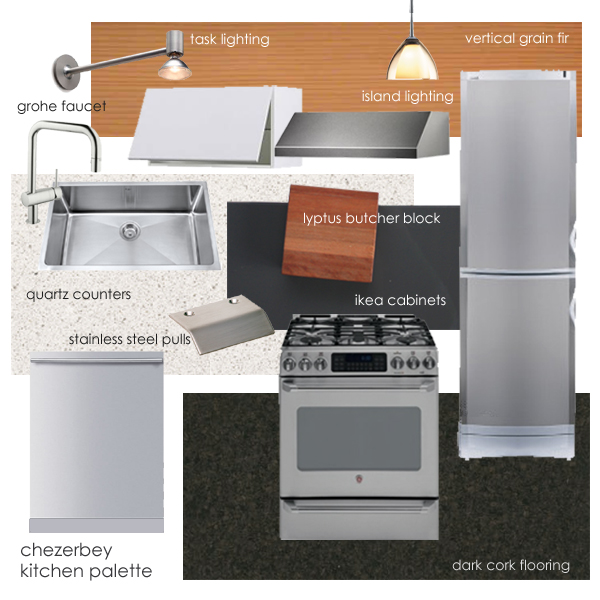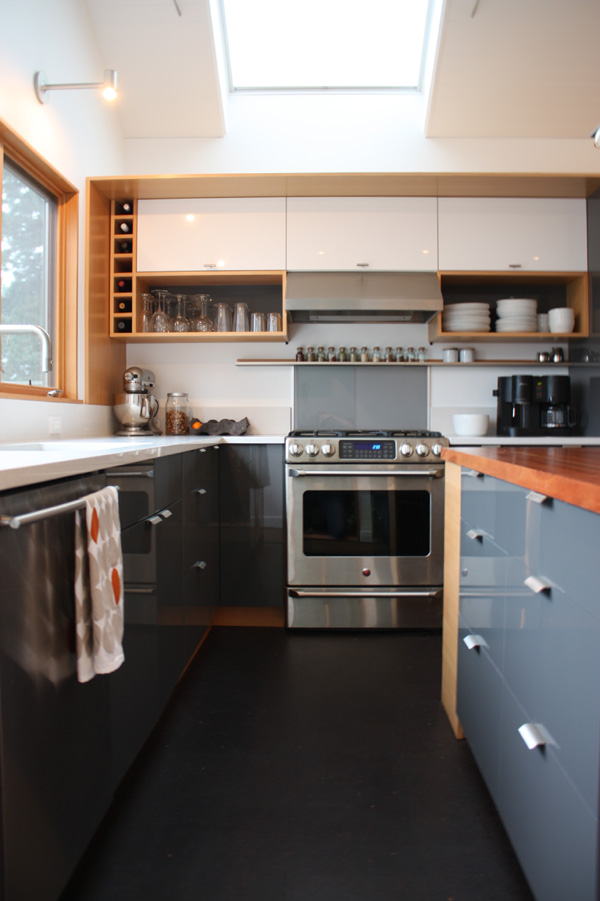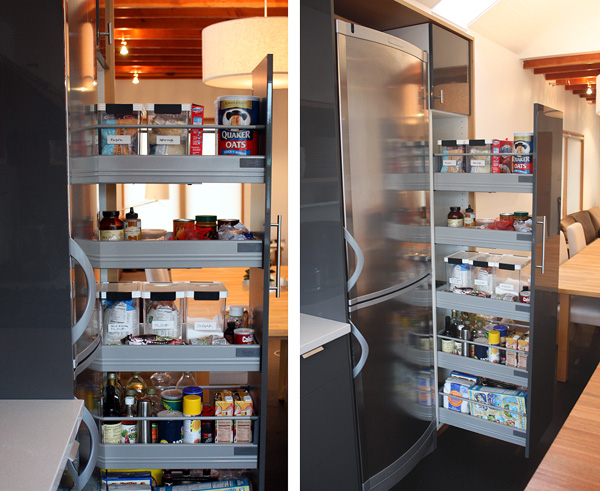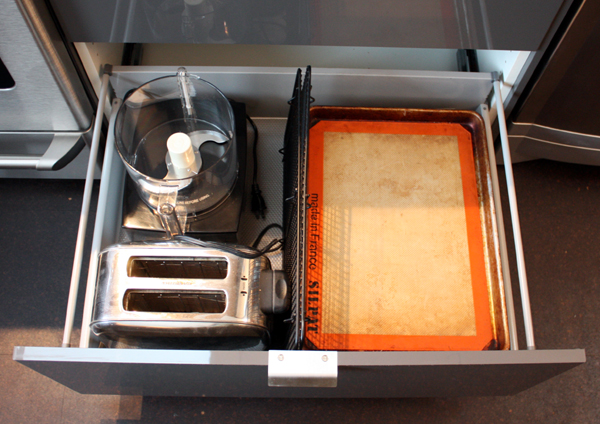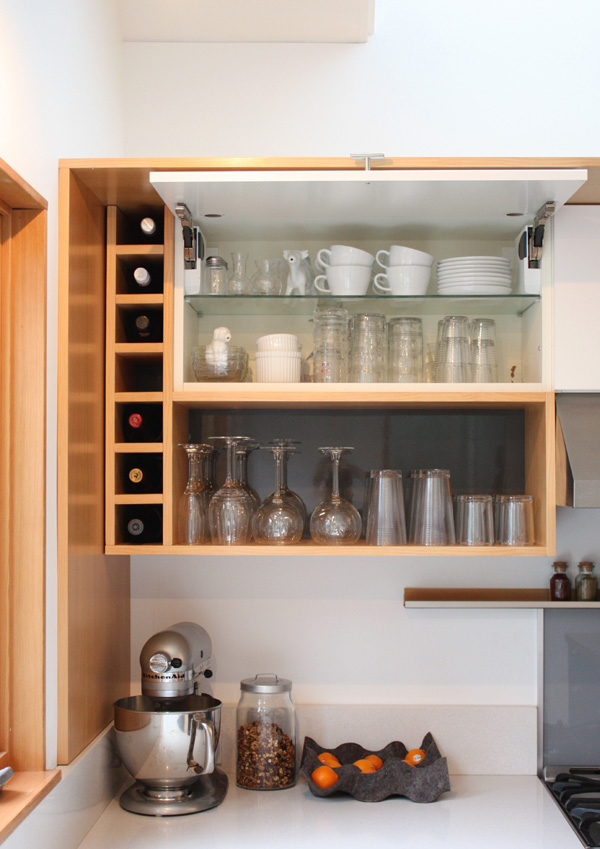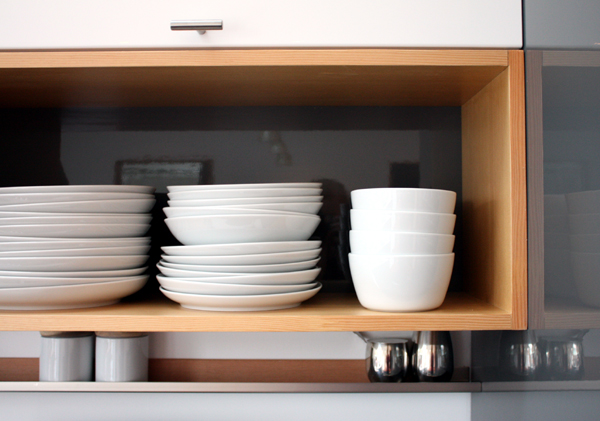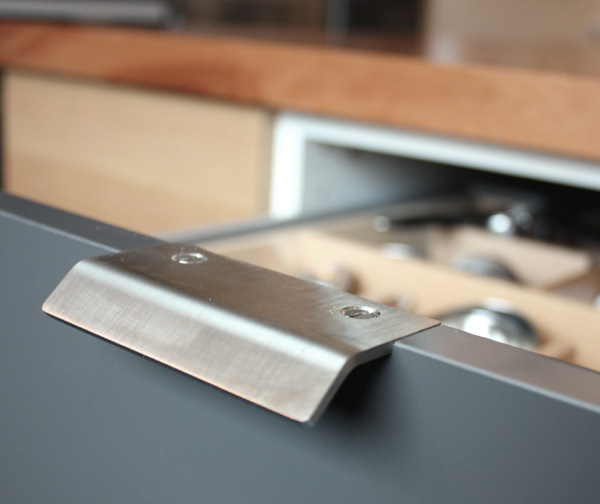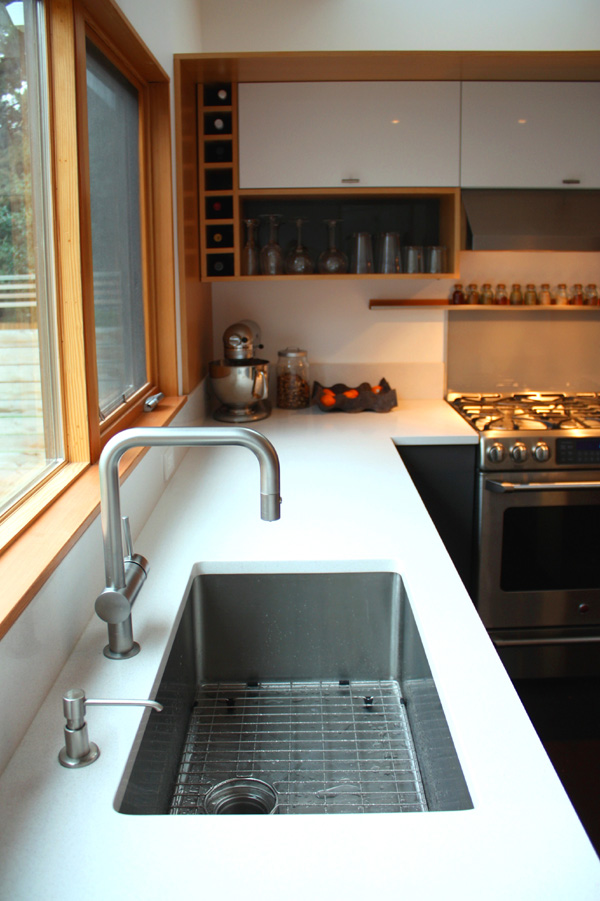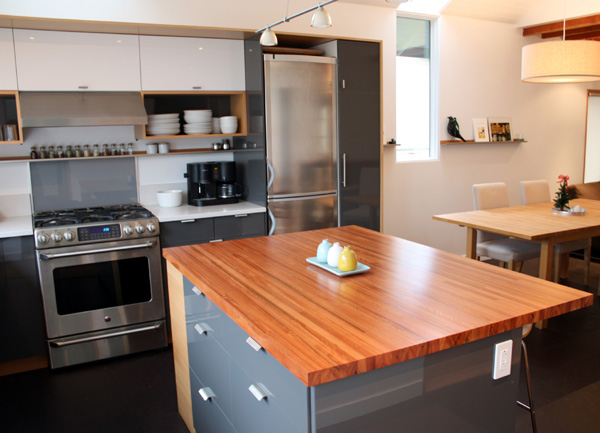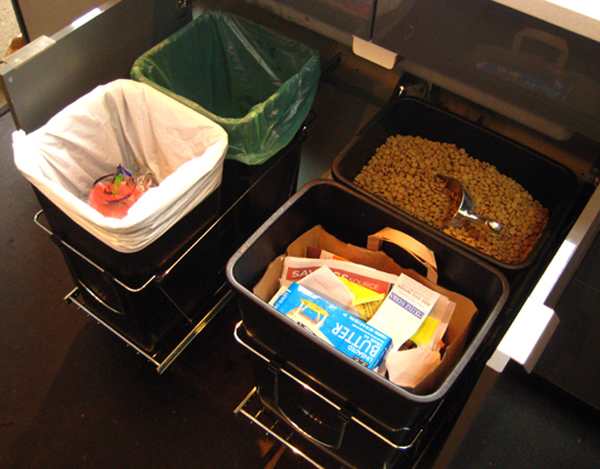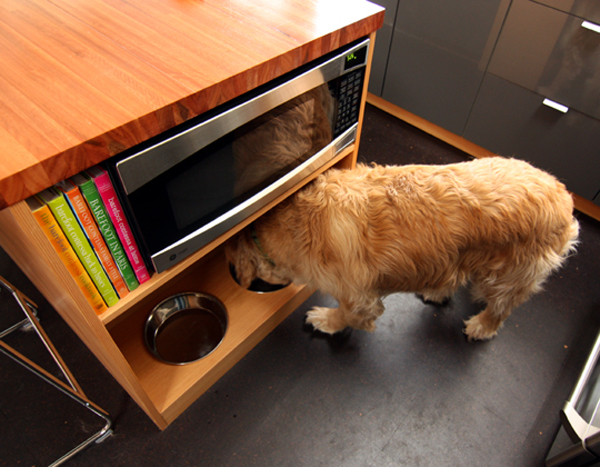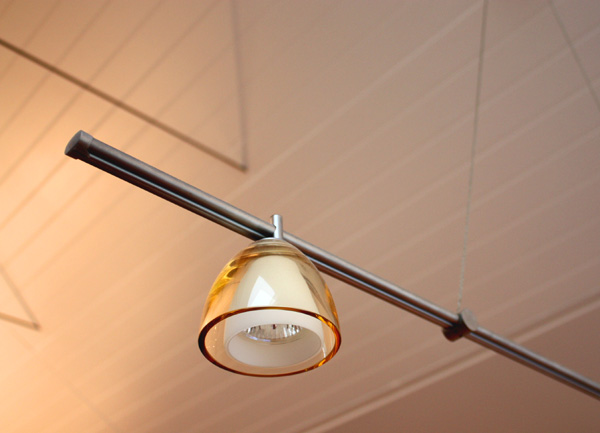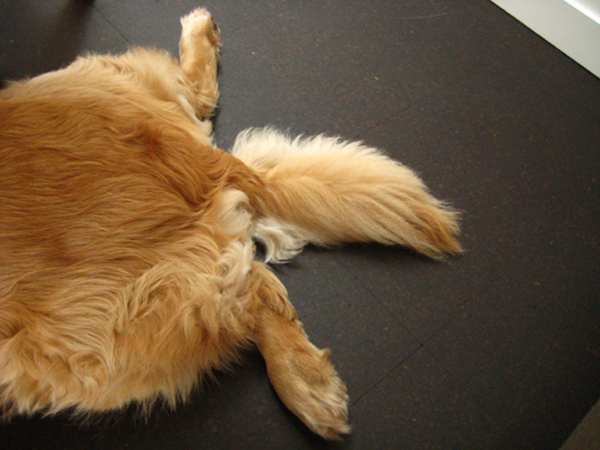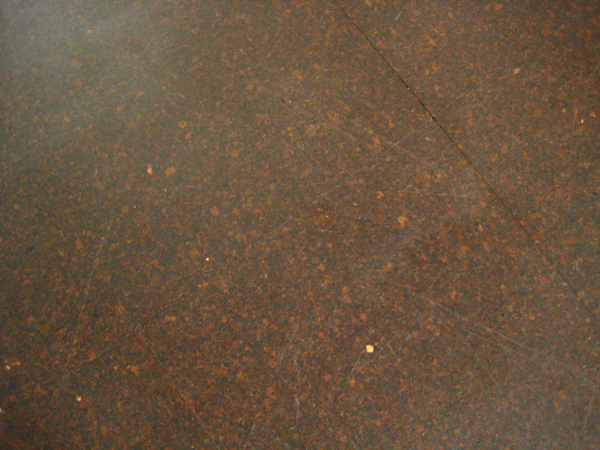It’s been just about 8 months since we finished (and revealed) our new kitchen, so we thought it was a good time to report back and let you know how we like it.
(Don’t remember the horror that it was before? Click here.)
Before we picked up a sledgehammer, we spent a lot of time designing the space and researching various fixtures, appliances, materials, etc. Below is the final materials palette that we assembled in May 2010 which represents the actual products used. For a complete list of everything we chose, check out the resources page.
Cabinets
Starting out, we were a little skeptical about the quality and durability of IKEA cabinets. But after reading a number of good reviews we decided to just go for it and so far, we’ve been very impressed. Granted, custom cabinets would have been better crafted and more durable, but for us this was an area where we could save a substantial amount of money without sacrificing function or our overall design ideas. We also came up with a layout that uses IKEA components but doesn’t scream “hey there, I’m an IKEA kitchen!”.
So far, we have had no issues with the functionality of the cabinets. (There is a slight squeak when you turn the carousel in the lazy susan cabinet, but I haven’t been motivated/annoyed enough yet to take everything out and remedy the problem.) Aesthetically, one minor issue to keep in mind is if you’re using white frames and a darker cabinet/drawer face, you can sometimes see a bit of the white behind if the faces don’t precisely line-up (and they often don’t). At first we were concerned and even corrected the issue on one cabinet by adding a piece of black electrical tape over the frame edge to create a “reveal” of sorts. It worked fine but we never got around to doing it on the other cabinets and unless you’re standing directly in front of the gap and crouched down, you never really notice.
The pull-out pantry has been a lifesaver for storing food in a small kitchen (we also use one of the island drawers for snack food items).
The “soft close” hardware? Totally worth it. Totally awesome.
Another great thing about IKEA is that, contrary to popular belief, you’re not limited to small drawers and cabinets. The unit to the right of the range is 36″ wide and deep enough to store the food processor, large baking sheets and the toaster (I know, a little weird, but the toaster is ugly and must be hidden from view at all times).
For the three upper cabinets, we installed the special hinges that allow the doors to stay open and then softly close with a slight tap when you’re done. Again, a must-have for cabinets at this height. Kyle made the two open shelves and wine rack out of fir plywood (with a fir edge band). At first we were apprehensive about the open shelving from a dust standpoint (aesthetically though, two thumbs up), but because these are our “everyday” dishes they aren’t on the shelf long enough to get dusty. The wine glasses are an exception, especially since we like to drink almost everything out of the smaller tumblers on the right. So we might shuffle those around one of these days.
We’ve noticed a slight discoloration on the wood where the stacks of dishes are, but it doesn’t bother us and you won’t be able to see the discrepancy unless we rearrange.
The steel drawer pulls were a splurge, but we know they’ll last forever. The only minor complaint I have is that they can act as a mini-shelf for crumbs, especially at the island where most of the food prep happens.
Plumbing Fixtures
We purchased (and still own) three kitchen sinks. The first was a double-basin that we foolishly bought several years ago. After nearly four frustrated years of our double-basin Sears Roebuck sink (seriously, did people not have pots and pans back in the day??), we were single-basin converts. The second sink was a cheaper single-basin that we picked up at a shady location in South Seattle. It was ok, but we were concerned about the quality (the brand was unknown). Finally we found this Kraus sink on Craigslist. I love this sink. It’s clean and modern, but the slight radius of the inside corners means there’s no place for gunk to collect. At first I was indifferent to the rack that sits on the bottom, but have since found that it keeps the bottom of the sink from getting scratched and allows air to circulate around dishes that get left in the sink overnight (or for a few days). Oh, and undermount vs. self-rimming – this is not even a discussion worth having with yourself.
The Grohe Minta faucet was another splurge (although we did get it at a discounted price), but it was worth it. It is incredibly durable and we haven’t had a single issue with the retractable pull-out sprayer (when you turn the faucet off, it pulls the sprayer hose back into the faucet). Oh, and it’s pretty.
The adjacent soap pump has been a great way to free up counter space and even though we initially planned on a separate water filter, we eventually nixed the idea. The modern filter faucets were almost as expensive as the main faucet and after drinking out of our bathroom sink for a few months we decided that the water quality was actually pretty good. Problem solved, money saved.
Countertops
For the countertops we mainly wanted something that was durable and would reflect light. We collected a bunch of different samples and ultimately ended up with Silestone composite quartz in “white north”. By purchasing the countertops through IKEA we got a discount. By sweet-talking the dealer into an architect discount, we saved a little more. (Sadly, we could not talk them into a “double architect” discount. Damn. Why does the double architect discount never work??) Anyhow, the quartz is very durable and easy to clean. The seam at the corner is nearly invisible and I generally have to show people where it is for them to notice. Silestone was not the cheapest option out there, but knowing that the counters would be one of the most abused surfaces in the house we knew it would be a good investment.
For the island, we opted for butcherblock for a few different reasons. First, a solid piece of Silestone that size would have been crazy expensive. (Aesthetically, I think our kitchen proves that you don’t have to have matching countertops or matching cabinets to make it feel cohesive.) We also liked the idea of the island being a true work surface and a place where people could gather to help prep a meal. We looked at several different butcherblock options (including IKEA), but ultimately decided on Lyptus, which had a coloring similar to the surrounding fir wood and was surprisingly affordable. (To save on costs, we bought one 12′ counter depth piece, cut it in half and biscuited the two panels together.) Even though the intention was to use it as a giant chopping block, it was so new and pretty that I’m still pulling out the cutting boards. Over time I’m sure we’ll eventually transition to cutting directly on it, but at least we know we can always sand it down and refinish it (with a food-grade finish) if we want it to look all pretty and new again.
Trash
You know how excited I was about our fancy waste organization system. 8 months in it’s still doing its job. We knew summer would be the real challenge though – right around this time of year we start to get fruit flies and of course they love to hang out in the compost container. Our temporary solution? We converted the cookie jar to a countertop compost container. It doesn’t have a charcoal filter or any of that fancy-ness, but as long as we empty it every couple of days, we’re ok. For larger items (pizza boxes, egg cartons, etc.) we just take them straight to our yard waste/compost container.
Appliances
It’s hard to find something to dislike about our range, mainly because it was a huge upgrade from every other cheapo electric range we’ve had in the past. We purchased a scratch & dent GE Cafe dual fuel (convection oven with gas range). It has the professional styling w/o the crazy expensive price tag and the flaw was on the side of the appliance and not visible. Cooking with gas has been great and the only downside is that the cooktop surface is harder to clean than the glass-top electric varieties.
After living with our stupid, non-functional (and brown!) range hood, we made it a priority to find the best hood we could afford. We purchased a simple and modern model from Vent-A-Hood. At an equivalent 900 CFM’s, it is certainly powerful. The only negative? It’s loud. This probably has more to do with the way it’s ducted, but at least I don’t have to fear high temperature cooking anymore. (You don’t want to see what Bailey does when the smoke alarm goes off.)
Even though we briefly considered not having a microwave, I’m glad we found a way to incorporate one in without it being all in your face. The location works well and even though it’s lower than counter height, it hasn’t been a problem to use.
(Note: our fridge and dishwasher were purchased in 2006 when we moved in.)
And what does Bailey think about his custom dog bowl station? Well, he doesn’t really care as long as we put food in there twice a day. Storing the food within an arm’s reach under the sink was a good move, especially when Bailey wakes me up at 5:30 every morning. Does he wake me up to go to the bathroom? No. He wants to eat. So every morning I make him go outside first, then stumble bleary-eyed to the kitchen and feed him before going back to bed.
Lighting
Lighting has been one of the areas that we were most nervous about (so expensive! so many options!) but that we’re really pleased with. Almost all of our fixtures are made by different companies but everything meshes together while also serving its intended purpose.
The Bruck linear chandelier over the island provides good task lighting and is elegant enough that it doesn’t overwhelm the space. The two wall-mounted reach lights above the kitchen window provide additional task lighting and are only used if we’re cooking at night. The undercabinet LED lights also don’t get used all of the time, but serve as additional lighting and sometimes as a nightlight when we have guests staying with us.
Flooring
I know this is probably the product people were the most skeptical about: the cork flooring. So here’s what we like about it: the color, the texture, the easy maintenance and the slight cushion underfoot. What don’t we like? Here’s a clue:
To back up just a little bit, we ordered our cork tiles prefinished with a hardwax oil. For whatever reason, they didn’t come that way so the dealer and manufacturer ended up splitting the cost to have a floor company come out and apply a wax finish over the installed tiles. We chose a wax finish over a polyurethane one because it could be spot repaired and since the cork was throughout most of the house, we thought that would be a good thing. We also thought that even though we have a dog, he isn’t the type that runs in circles around the house (in other words, he’s kinda lazy). The thing we didn’t completely realize? He likes to lay “froggy style” and as a result his back claws tend to scratch the floor every time he scrambles to his feet. You can see a little bit of that here:
So what to do? Fortunately, the scratches are just in the wax and not the cork itself. I haven’t tried to do a true spot repair yet but it’s on the list. Since wax is a “buildable” finish, adding more layers will increase the life of the flooring and this might be the strategy we need to put in place. We’ve also though about scrapping the wax and going with a poly finish but this would mean emptying out the house and most likely hiring the work out. We’re going to live with the flooring and try a few spot repairs for now, but if we’re still not happy in a year or two we’ll weigh the different options.
So all in all, we feel like our research has paid off. The space functions well, is comfortable, easy to clean and is a bazillion times better than the shameful 5-doored room that was our old kitchen.
Want to read through all of our kitchen-related posts? Pour yourself some coffee and click here.
